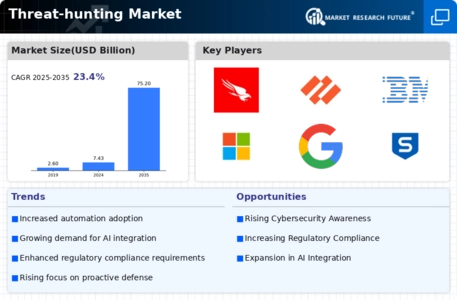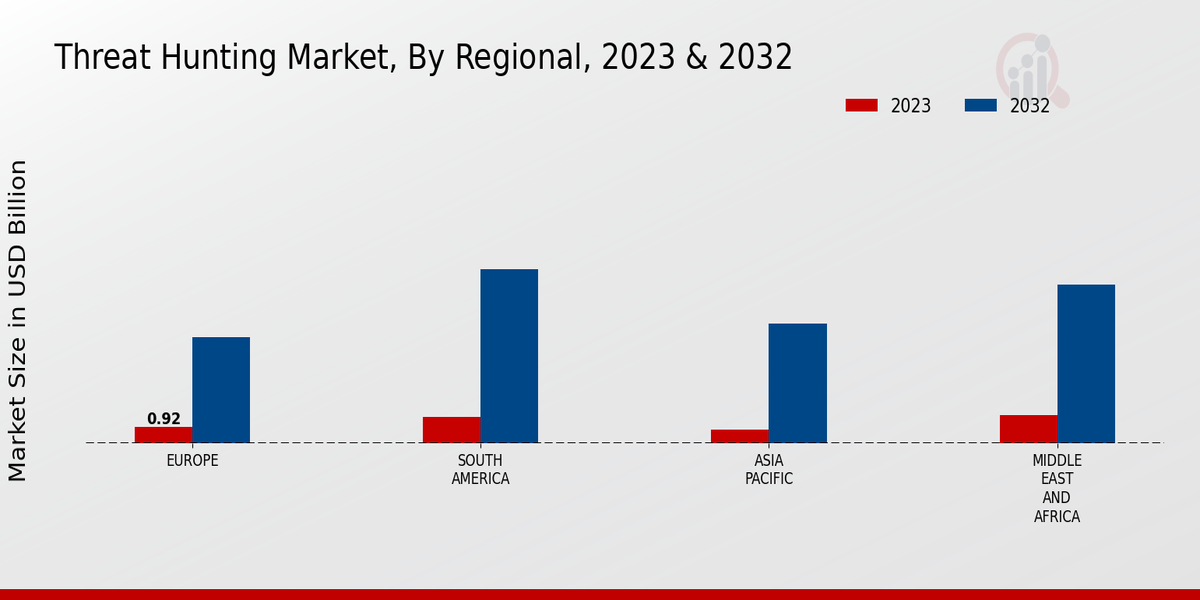Market Growth Projections
The Global Threat-hunting Market Industry is poised for substantial growth, with projections indicating a market size of 7.43 USD Billion in 2024 and an anticipated increase to 75.2 USD Billion by 2035. This growth trajectory reflects a compound annual growth rate (CAGR) of 23.41% from 2025 to 2035, underscoring the escalating demand for threat-hunting solutions. The market's expansion is driven by various factors, including rising cybersecurity threats, regulatory compliance requirements, and the adoption of advanced technologies. As organizations increasingly recognize the importance of proactive threat-hunting strategies, the market is expected to flourish in the coming years.
Rising Cybersecurity Threats
The increasing frequency and sophistication of cyber threats drives the Global Threat-hunting Market Industry. Organizations face a myriad of attacks, including ransomware, phishing, and advanced persistent threats. In 2024, the market is projected to reach 7.43 USD Billion, reflecting a growing recognition of the need for proactive threat-hunting strategies. Companies are investing in advanced technologies and skilled personnel to detect and mitigate these threats before they escalate. This trend is expected to continue as cybercriminals evolve their tactics, necessitating a robust threat-hunting approach to safeguard sensitive data and maintain operational integrity.
Adoption of Advanced Technologies
The integration of advanced technologies such as artificial intelligence and machine learning is transforming the Global Threat-hunting Market Industry. These technologies enhance the ability to detect anomalies and predict potential threats, allowing organizations to respond swiftly. The adoption of these tools is expected to accelerate market growth, as they provide a more efficient means of identifying vulnerabilities. Companies are increasingly leveraging these technologies to automate threat-hunting processes, thereby reducing response times and improving overall security posture. This trend aligns with the projected CAGR of 23.41% from 2025 to 2035, indicating a robust future for the market.
Regulatory Compliance Requirements
Stringent regulatory frameworks compel organizations to adopt threat-hunting practices, thereby influencing the Global Threat-hunting Market Industry. Regulations such as GDPR and HIPAA mandate strict data protection measures, pushing companies to implement proactive security measures. Non-compliance can result in hefty fines and reputational damage, prompting businesses to invest in threat-hunting solutions. As organizations strive to meet these regulatory demands, the market is anticipated to grow significantly. The increasing emphasis on compliance is likely to contribute to the market's expansion, with projections indicating a rise to 75.2 USD Billion by 2035, driven by the need for comprehensive security strategies.
Increased Investment in Cybersecurity
Organizations are allocating substantial budgets to bolster their cybersecurity frameworks, significantly impacting the Global Threat-hunting Market Industry. As cyber threats become more prevalent, companies recognize the necessity of investing in threat-hunting capabilities to protect their assets. This trend is evident in the rising expenditures on cybersecurity solutions, which are projected to continue growing. The commitment to enhancing security measures is likely to drive the market's expansion, as businesses seek to implement comprehensive threat-hunting strategies. The increasing financial commitment to cybersecurity reflects a broader understanding of the risks associated with inadequate protection.
Growing Awareness of Cybersecurity Risks
The heightened awareness of cybersecurity risks among organizations is a pivotal driver for the Global Threat-hunting Market Industry. As high-profile breaches make headlines, companies are becoming more cognizant of the potential consequences of cyberattacks. This awareness is prompting businesses to prioritize threat-hunting initiatives as part of their overall security strategy. Organizations are investing in training and resources to equip their teams with the necessary skills to identify and respond to threats effectively. This cultural shift towards proactive security measures is likely to sustain market growth, as companies recognize the importance of being prepared for evolving cyber threats.


























